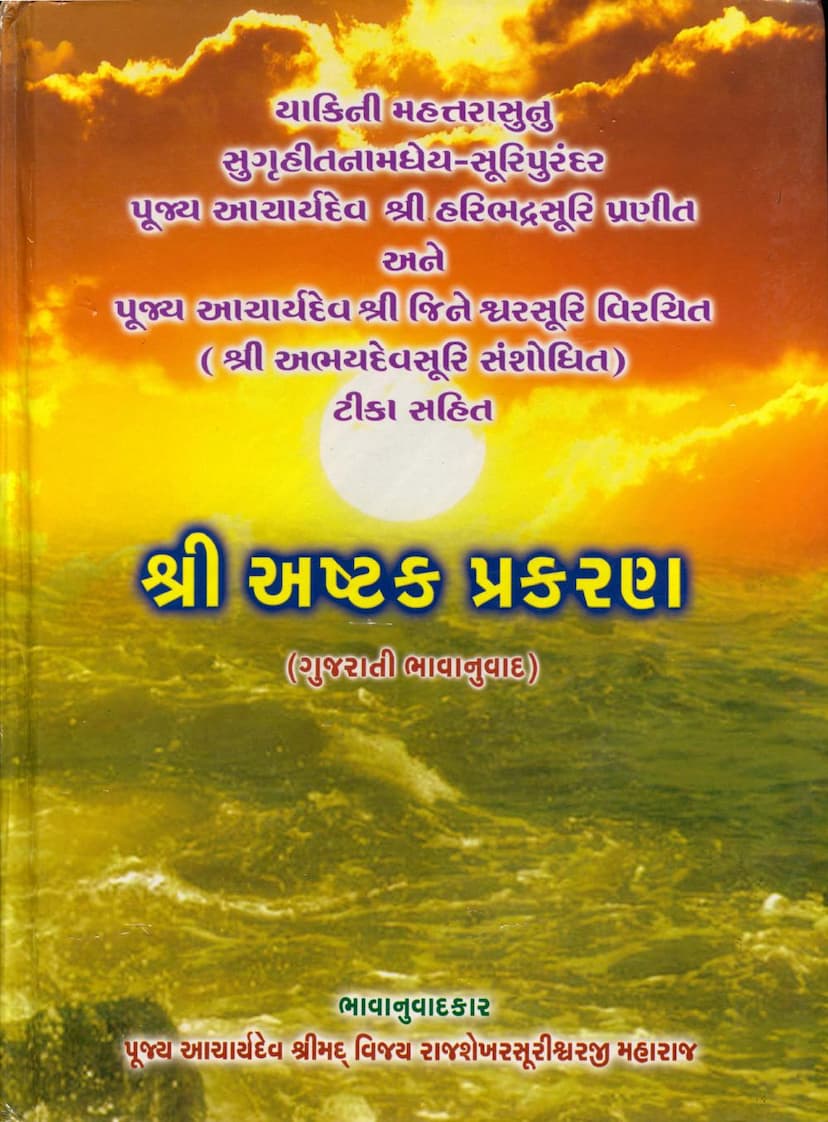Ashtak Prakaran
Added to library: September 1, 2025

Summary
This comprehensive summary outlines the key aspects of the Jain text "Ashtak Prakaran" by Acharya Rajashekhar Suri, based on the provided pages.
Title: Shri Ashtak Prakaran (श्री अष्टक प्रकरण) Author: Acharya Rajashekhar Suri (राजशेखर्सुरि) Publisher: Arihant Aradhak Trust (श्री अरिहंत आराधक ट्रस्ट) Commentary: By Acharya Jineshwarsuri (श्रीमद् विजय जिनेश्वरसूरीश्वरजी महाराज), revised by Acharya Abhaydevsuriji (श्री अभयदेवसूरीश्वरजी म.सा.) Language: Gujarati Translation and Commentary (ગુજરાતી ભાવાનુવાદ)
Overall Summary:
The "Ashtak Prakaran" is a significant Jain text that delves into various aspects of Jain philosophy and practice. It is structured into thirty-two "Ashtaks" (sections), each focusing on a specific topic. The provided pages offer a glimpse into the first few Ashtaks, particularly the "Mahadev Ashtak" (First Ashtak) and the beginning of the "Snan Ashtak" (Second Ashtak), along with introductory and concluding remarks. The text aims to provide profound spiritual guidance and clarify complex philosophical concepts for the benefit of the Jain community.
Key Features and Content from the Provided Pages:
-
Spiritual Lineage and Reverence: The text begins with invocations and salutations to prominent Jain Acharyas, including Acharya Haribhadra Suri (the original author of the "Ashtak Prakaran"), Acharya Jineshwarsuri (commentator), Acharya Abhaydevsuriji (reviser), and Acharya Shrimad Vijay Rajashekhar Surishwarji Maharaj (the translator and commentator of the Gujarati version). This highlights the importance of guru-parampara and reverence for spiritual masters in Jainism.
-
Purpose of the Text: The text is intended to clarify the true nature of the "Mahadev" (a term used in Jainism to refer to the liberated soul or omniscient beings like Tirthankaras) and to guide individuals on the path of spiritual practice. It emphasizes the importance of adhering to divine commandments (Aadnya) as the true way to worship the Vitaraags (Tirthankaras).
-
Mahadev Ashtak (First Ashtak):
- Definition of Mahadev: The first Ashtak focuses on defining what constitutes a "Mahadev" in Jainism. It states that a Mahadev is one who is devoid of attachment (Vitarag), possessors of omniscience (Sarvajna), eternally blissful, and free from all types of karma and impurities.
- Rejection of Idol Worship/Misconceptions: A significant portion of the first Ashtak (as seen in the detailed commentary) critiques the popular notions of deities in other traditions, contrasting them with the Jain ideal of Mahadev. It elaborates on how various Hindu deities (Brahma, Vishnu, Shiva, Surya, etc.) are depicted with human-like flaws, limitations, and mythological stories that are considered incompatible with the ultimate spiritual goal. The text refutes the idea that these deities, with their imperfections, can be considered ultimate Mahadevas.
- Characteristics of Mahadev: The text emphasizes that the true Mahadev is free from attachment, hatred, and delusion, possesses perfect knowledge, and has infinite auspicious qualities. The path to achieving this state is through diligent practice of divine commandments, adherence to scriptural teachings, and the cultivation of virtues.
-
Snan Ashtak (Second Ashtak):
- Two Types of Snan (Bathing): The second Ashtak begins to discuss the concept of "Snan" (bathing), distinguishing between two main types:
- Dravya Snan (External Bathing): This refers to the physical purification of the body using water and other cleansing agents.
- Bhava Snan (Internal Bathing): This refers to the purification of the mind and soul through spiritual practices, contemplation, and detachment.
- The Importance of Bhava Snan: The text emphasizes that internal purification (Bhava Snan) is the ultimate goal, as it leads to spiritual liberation, while external bathing is merely a preparatory or symbolic act.
- Critique of Ritualistic Bathing: The text implicitly criticizes those who solely focus on external rituals without internal purification, suggesting that such practices are ultimately insufficient for spiritual progress.
- Two Types of Snan (Bathing): The second Ashtak begins to discuss the concept of "Snan" (bathing), distinguishing between two main types:
-
Emphasis on Knowledge and Practice: The "Ashtak Prakaran" highlights that true spiritual understanding comes from diligent study of scriptures, contemplation, and adherence to the teachings of the Jinas. It stresses the importance of correct knowledge (Samyak Darshan, Samyak Gyan, Samyak Charitra) as the foundation for spiritual progress.
-
Rejection of Other Philosophical Views: The text, particularly in the "Mahadev Ashtak," actively refutes and clarifies the Jain perspective by distinguishing it from the doctrines and practices of other religious and philosophical traditions, implicitly critiquing their reliance on flawed deities or incomplete spiritual paths.
-
Structure and Scholarship: The detailed commentary suggests a deep scholarly tradition behind the text, with explanations and elaborations of the original verses, addressing potential doubts and offering nuanced interpretations. The inclusion of indices for verses further enhances the text's usability for scholars.
Overall Significance:
The "Ashtak Prakaran" serves as a foundational text for understanding core Jain principles. It provides a rigorous philosophical framework and practical guidance for spiritual aspirants. The text's comprehensive approach, covering definitions of ultimate beings, rituals, and ethical conduct, makes it a valuable resource for Jain scholars and practitioners alike. The emphasis on Aadnya Abhyas (practice of commandments) as the path to true spiritual realization is a central theme.